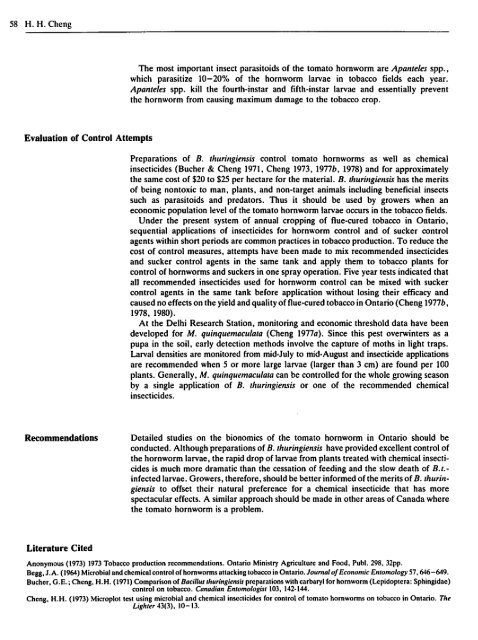pdf, 57.71Mb - Entomological Society of Canada
pdf, 57.71Mb - Entomological Society of Canada
pdf, 57.71Mb - Entomological Society of Canada
Create successful ePaper yourself
Turn your PDF publications into a flip-book with our unique Google optimized e-Paper software.
58 H. H. Cheng<br />
Evaluation <strong>of</strong> Control Attempts<br />
Recommendations<br />
Literature Cited<br />
The most important insect parasitoids <strong>of</strong> the tomato homworm are Apanteles spp.,<br />
which parasitize 10-20% <strong>of</strong> the hom worm larvae in tobacco fields each year.<br />
Apanteles spp. kill the fourth-instar and fifth-instar larvae and essentially prevent<br />
the homworm from causing maximum damage to the tobacco crop.<br />
Preparations <strong>of</strong> B. thllringiensis control tomato hornworms as well as chemical<br />
insecticides (Bucher & Cheng 1971. Cheng 1973. 1977b, 1978) and for approximately<br />
the same cost <strong>of</strong> $20 to $25 per hectare for the material. B. thllringiensis has the merits<br />
<strong>of</strong> being nontoxic to man. plants, and non-target animals including beneficial insects<br />
such as parasitoids and predators. Thus it should be used by growers when an<br />
economic population level <strong>of</strong> the tomato horn worm larvae occurs in the tobacco fields.<br />
Under the present system <strong>of</strong> annual cropping <strong>of</strong> Due-cured tobacco in Ontario,<br />
sequential applications <strong>of</strong> insecticides for homworm control and <strong>of</strong> sucker control<br />
agents within short periods are common practices in tobacco production. To reduce the<br />
cost <strong>of</strong> control measures, attempts have been made to mix recommended insecticides<br />
and sucker control agents in the same tank and apply them to tobacco plants for<br />
control <strong>of</strong> hornworms and suckers in one spray operation. Five year tests indicated that<br />
all recommended insecticides used for homworm control can be mixed with sucker<br />
control agents in the same tank before application without losing their efficacy and<br />
caused no effects on the yield and quality <strong>of</strong> Due-cured tobacco in Ontario (Cheng 1977b,<br />
1978, 1980).<br />
At the Delhi Research Station, monitoring and economic threshold data have been<br />
developed for M. qllinquemaculata (Cheng 1977a). Since this pest overwinters as a<br />
pupa in the soil, early detection methods involve the capture <strong>of</strong> moths in light traps.<br />
Larval densities are monitored from mid-July to mid-August and insecticide applications<br />
are recommended when 5 or more large larvae (larger than 3 cm) are found per 100<br />
plants. Generally. M. qllinqllemacillata can be controlled for the whole growing season<br />
by a single application <strong>of</strong> B. thllringiensis or one <strong>of</strong> the recommended chemical<br />
insecticides.<br />
Detailed studies on the bionomics <strong>of</strong> the tomato hornworm in Ontario should be<br />
conducted. Although preparations <strong>of</strong> B. thuringiensis have provided excellent control <strong>of</strong><br />
the hornworm larvae, the rapid drop <strong>of</strong> larvae from plants treated with chemical insecticides<br />
is much more dramatic than the cessation <strong>of</strong> feeding and the slow death <strong>of</strong> B.t.infected<br />
larvae. Growers, therefore, should be better informed <strong>of</strong>the merits <strong>of</strong> B. thuringiensis<br />
to <strong>of</strong>fset their natural preference for a chemical insecticide that has more<br />
spectacular effects. A similar approach should be made in other areas <strong>of</strong> <strong>Canada</strong> where<br />
the tomato hornworm is a problem.<br />
Anonymous (1973) 1973 Tobacco production recommendations. Ontario Ministry Agriculture and Food, Pub!. 298. 32pp.<br />
Begg, J.A. (1964) Microbial and chemical control <strong>of</strong> homworms attacking tobacco in Ontario. Journal <strong>of</strong> Economic Entomology 57, 646-649.<br />
Bucher, G .E.; Cheng, H. H. (1971) Comparison <strong>of</strong> Bacillus Ihuringiensis preparations with carbaryl for homworm (Lepidoptera: Sphingidae)<br />
control on tobacco. Canadian Entomologist 103, 142-144.<br />
Cheng. H.H. (1973) Microplot test using microbial and chemical insecticides for control <strong>of</strong> tomato homworms on tobacco in Ontario. The<br />
Lighter 43(3). 10-13.
















